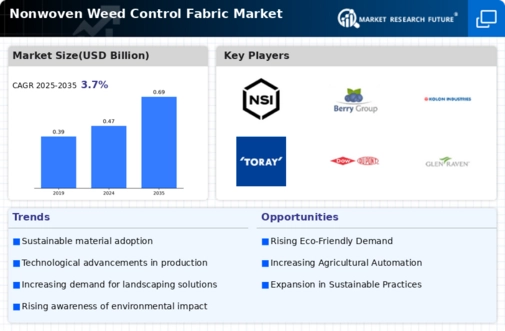Market Growth Projections
Rising Demand for Sustainable Agriculture
The Global Nonwoven Weed Control Fabric Market Industry is experiencing a notable increase in demand driven by the growing emphasis on sustainable agricultural practices. Farmers are increasingly adopting nonwoven fabrics as an eco-friendly alternative to chemical herbicides. This shift not only promotes soil health but also aligns with global sustainability goals. As a result, the market is projected to reach 0.47 USD Billion in 2024, reflecting a significant uptick in usage among environmentally conscious growers. The trend towards organic farming and sustainable land management practices is likely to further bolster the demand for nonwoven weed control solutions.
Regulatory Support for Eco-Friendly Products
Regulatory frameworks promoting eco-friendly products are influencing the Global Nonwoven Weed Control Fabric Market Industry positively. Governments worldwide are implementing policies that encourage the use of sustainable materials in agriculture and landscaping. This regulatory support not only fosters innovation in the production of nonwoven fabrics but also incentivizes farmers and landscapers to adopt these environmentally friendly solutions. As a result, the market is likely to benefit from increased investments in research and development, further enhancing the appeal of nonwoven weed control fabrics in various applications.
Growth in Landscaping and Gardening Activities
The surge in landscaping and gardening activities globally is significantly contributing to the growth of the Global Nonwoven Weed Control Fabric Market Industry. As urbanization continues to expand, more individuals and businesses are investing in outdoor spaces, leading to increased demand for effective weed control solutions. Nonwoven fabrics are favored for their ability to provide long-lasting protection against weeds while allowing water and nutrients to penetrate the soil. This trend is expected to sustain the market's growth trajectory, with projections indicating a market value of 0.69 USD Billion by 2035, driven by the ongoing interest in beautifying outdoor environments.
Technological Advancements in Fabric Production
Innovations in the production of nonwoven weed control fabrics are playing a crucial role in the expansion of the Global Nonwoven Weed Control Fabric Market Industry. Advanced manufacturing techniques, such as spunbond and meltblown processes, enhance the durability and effectiveness of these fabrics. These advancements not only improve the performance of weed control but also reduce production costs, making them more accessible to a wider range of consumers. As the industry continues to evolve, the market is expected to grow at a CAGR of 3.62% from 2025 to 2035, indicating a robust future driven by technological progress.
Increasing Awareness of Weed Management Solutions
The Global Nonwoven Weed Control Fabric Market Industry is witnessing heightened awareness regarding effective weed management solutions among agricultural stakeholders. Educational initiatives and outreach programs are informing farmers about the benefits of using nonwoven fabrics to suppress weed growth while minimizing environmental impact. This awareness is translating into increased adoption rates, particularly in regions where traditional weed control methods are less effective. As the market matures, the emphasis on integrated weed management strategies is likely to further enhance the appeal of nonwoven fabrics as a viable solution.


















